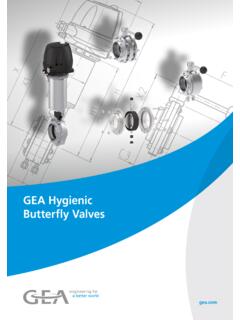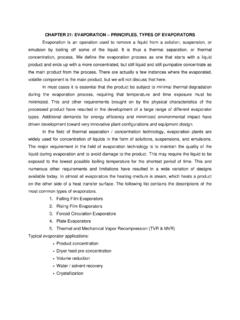Transcription of Technology and Applications - GEA engineering for a better ...
1 GEA Process EngineeringTechnology and ApplicationsEvaporation Technology Using Mechanical Vapour Recompressionengineering for a better world2 Evaporation Technology using mechanical vapour recompressionThermal separation processes such as evaporation and distillation are energy intensive. In the course of their development, the aim of efficiently using this energy and of reducing costs first led to single-effect plants heated by live steam, then to multiple-effect plants, then to thermal vapour recompression, and finally, to the use of mechanical vapour recompression conventional evaporators, the energy content of the vapour stream pro - duced is lost to a large extent or is only partially used. In comparison, mechan- ical vapour recompression permits the continuous recycling of this energy stream by recompressing the vapour to a higher pressure and therefore, a higher energy content.
2 Instead of live steam, electric energy is used indi-rectly to heat the vapour recompression reduces the energy costs and the CO2 foot - print and, consequently the environmental designed to save energy in evaporation plants 3 Types of construction of mechanical vapour recompressors 7 Principles of function and design features 10 Regulating the capacity of mechanical vapour recompression systems 11 Energy optimization of existing multiple-effect plants by means of mechanical vapour recompression 12 Examples for evaporation plants with centrifugal fans 14 Examples for evaporation plants with turbo-compressors 17 Examples for plants with rotary blowers 183 Processes designed to save energy in evaporation plantsWhen evaporating fluids, heat is trans-ferred to the fluid to be evaporated.
3 In industrial-scale Applications , this process indirectly takes place via an evaporator that is used as a heat exchanger. This heat is used to heat the fluid and finally to eva-porate the solvent (in most cases water).Evaporation Technology Using Mechanical Vapour RecompressionMultiple-effect arrangementA Product to be eva poratedB VapourC ConcentrateD Heating steamF Heating steam con densateG Vapour condensateHeat flow diagram of a double-effect, directly heated evaporatorDecrease of the specific steam consumption in % and increase of the total heating surface o F depending on the number of effects The heat flow of a single-effect evapo-rator shows that the thermal energy included in the vapour (enthalpy) must be about the same as that of the thermal input on the heating side.
4 For the normal case of water evaporation, you can pro-duce 1 kg/h of vapour with 1 kg/h of live steam since the specific evaporation heat is about the same on the product side as on the heating this way, the concentration of the non-volatile substances in the fluid is in creased. The evaporated solvent is referred to as vapour. Thus, the produced vapour contains approximately the same thermal energy as the used heating steam, however, at a lower pressure and temperature level. During condensation, this thermal energy has to be dissipated using the vapour produced as heat-ing steam in a second effect, the energy requirement of the overall system will nearly halve. This principle can be continued over several effects in order to further improve the energy max.
5 Permissible heating tempera-ture of the first effect and the lowest boil-ing temperature of the last effect result Different heat carriers can be used to heat the evaporator. Apart from hot water or thermo-oil, water steam is used in most of the cases which condenses on the heating side of the evaporator and which dissipates its condensation heat on the evaporation a total temperature difference which can be distributed to the individual effects. The total heating surface to be used for all effects thus increases propor-tionally with the number of effects so that investment costs increase whereas energy saving falling film forced circulation evaporation plant with thermal vapour recompressor for waste water from monosodium glutamate production.
6 Evaporation rate: 50 t/hIn thermal vapour recompression, motive steam is used to compress part of the vapour produced in an evaporation effect from a lower evaporation pressure and temperature level to the heating pressure of the first evaporation designed to save energy in evaporation plantsA Product to be eva poratedB VapourC ConcentrateD Heating / motive steamG Vapour condensateHeat flow diagram of an evaporator with steam jet vapour recompressionIn this way, the heat energy included in this first effect can be used again for heating. The required heating steam will reduce to the motive steam quantity. For this purpose, steam jet vapour recom-pressors are used (thermo-compressors). They have no moving parts, ensuring a simple and effective design that pro-vides the highest possible operational Thermal vapour recompressionreliability.
7 The use of a thermal vapour recompressor has the same steam/energy saving effect as an additional evaporation effect. However, the steam jet vapour recompressor is incomparably more Technology Using Mechanical Vapour RecompressionA Product to be eva poratedB VapourC ConcentrateE Electrical energyG Vapour condensateHeat flow diagram of an evaporator with mechanical vapour recompressorUsing mechanical vapour recompression, a mechanically operated compressor recompresses practically the complete vapour of an evaporation effect from a lower evaporation pressure and tempera-ture level to the heating pressure of the same evaporation effect. In this way, its heat energy is re-used for heating and does not have to be condensed without being used.
8 Mechanical vapour recompressor (centrifugal fan) of a single-effect falling film evaporation plant in food productionContrary to thermal vapour recompres-sion, no motive steam is required, and practically only the drive energy which in most cases is electrical and which is necessary for the mechanical recom-pressor, will be required. The costs for energy requirements often are consider-ably lower than for thermally heated plants. A low additional thermal energy is needed to balance the overall heat requirement and to start-up the thermally heated plants, more or less all of the heating and/or motive steam energy has to be dissipated in the con-denser to cooling water. In mechanically heated plants only a small portion has to be dissipated.
9 This considerably reduces the energy requirement and also the re-sidual heat to be required power input of the me-chanical vapour recompressor is nearly proportional to the pressure and tem-perature difference that has to be over-come so that it directly depends on the installed heat exchanger surface. With increasing surface, the required power input will decrease. Pressure drops and, in particular a potential product-specific boiling point increase determine the compressor capacity to be installed and thus the specific energy requirement of an evaporation vapour recompressionACGEB6In many cases, the investment costs of an eva poration plant with mechanical vapour recompression are somewhat higher than for a comparable thermally heated plant.
10 This difference, however, is amortised in a relatively short term thanks to the low energy costs during falling film evaporation plant with mechanical vapour recompression for wheat starch effluent, evaporation rate: 17,000 kg/hThe diagram above shows an example for the period in which this investment cost difference can be amortised depend-ing on the price for steam and electrical power. The representation is based on an evaporation plant for an evaporation capacity of 20 t/h for a product with moderate boiling point elevation of K and a boiling temperature of 90 C. The comparison shows a four-effect Mechanical vapour recompression an investment that pays offfalling film evaporation plant with thermal vapour recompression and a single-effect falling film evaporator with an individ ual vapour recompressor (cen-trifugal fan).










